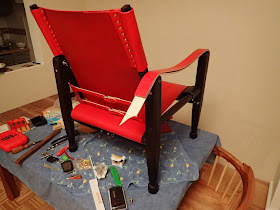One of the unnecessary challenges was using a drawknife on this dry lumber. One leg was nearly ruined because I took too heavy of a cut, and the resulting split dove deep into the surface. I felt I was really at the mercy of the grain here. I want to try this again, but next time instead of carving the legs with a knife, I will use a technique like the one Roy Underhill uses when making his bench hooks. I will make several relief cuts with a saw and chop out the bulk with a chisel. Then I can smooth it out with a spokeshave.
I also might go with the more angular look if I use this charred finish again.
I did really like using the knurled knobs for the back of the arm straps. I probably will do that again. I just ordered the same ones that Christopher Schwarz wrote about. It only took a few minutes to polish them on sharpening stones, and I think it might be fun to punch some initials in these. Also, I think it might make sense to install two threaded inserts closer together, permitting the use of fewer holes (or farther apart).
 |
| I like this. |
 |
| I like how the texture of the endgrain looks. |
The first one I did was this black one. I have this set up at home and use it to watch TV often. It seems to be holding up well.
I used pear wood for this one, which I have never heard of anyone else doing. Having not built one before, I followed Christopher Schwarz' instructions closely. With the exception of planing down the legs a bit farther than he suggests. This chairs legs a a slender 1 5/8" square, as opposed to CS' recommended 1 7/8". The result is a bit of a more slender look. It seems to be holding up so far.
 |
| Pear and black leather. |
 |
| Diamond willow chair. |
Janet was thrilled.
 |
| Coffee and Cream. |
If it does, it was purely by accident.
My opinion is this is a very striking chair that will dominate a room. Once again, I think it looks swank.
 |
| Red and black SSP chair. |
Until my next chair...
Finished Chair
Part I
Part II
Part III
Part IV
Part V
Part VI
















































